Finding the Best Bathroom Cleaners for Soap Scum
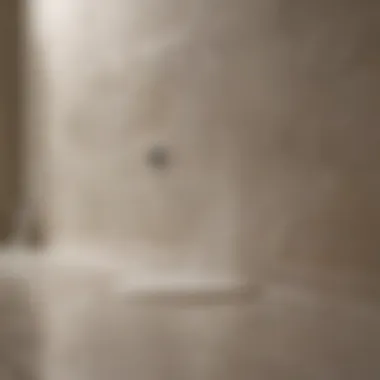
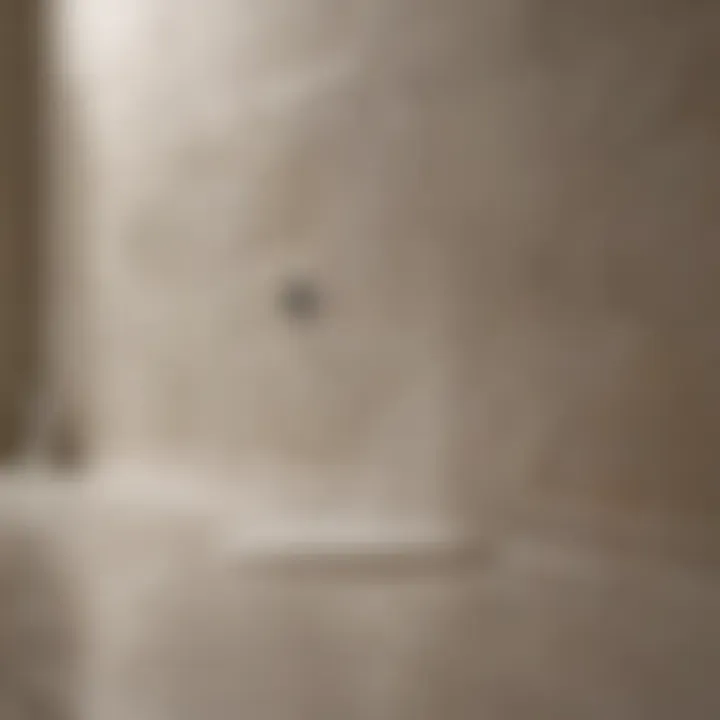
Intro
Soap scum is an unwelcome guest in many bathrooms, a persistent nuisance that tends to settle in when you least expect it. It's not just an eyesore; it's a breeding ground for bacteria and can be difficult to remove without the right tools. Understanding the nature of soap scum is crucial because it’s not a simple mixture of soap and water. It often contains minerals from hard water, leading to a sticky film that refuses to budge. That leads us to the real question: how do we tackle this menace effectively?
This guide will unfold a comprehensive analysis of the optimal bathroom cleaners, diving into various aspects such as product comparisons, DIY alternatives, and tips to achieve not only a clean but also an aesthetically pleasing bathroom. Whether you’re a house owner wanting to maintain a pristine environment or someone simply struggling to overcome the relentless build-up, this article aims to arm you with the necessary insights.
Throughout, we will touch on important factors like safety, environmental impact, and even some design inspirations—because who says functionality can’t be chic? The bottom line is this: a clean bathroom contributes significantly to the overall hygiene of your home, and being well-equipped to handle soap scum is essential.
Design Inspirations
Having a clean bathroom isn’t solely about removing grime; it’s also about creating an inviting and stylish space. There are several trends in bathroom design, from minimalist aesthetics to cozy retreats. These design inspirations can guide you as you declutter and rejuvenate your bathroom.
Trending Styles
Current bathroom styles lean heavily towards simplicity and functionality. Think clean lines and subdued colors that offer a serene atmosphere. For instance, the Scandinavian design trend promotes open space and natural light, making it easier to spot pesky soap scum before it gets out of control. On the other hand, vintage styles can create a warm ambiance. The charm of clawfoot tubs coupled with antique fixtures can add character, even if there's a little scum to scrub.
Color Palettes
The colors you choose can also influence your cleaning habits. A fresh palette of whites, grays, and light blues can invoke a sense of cleanliness, making dirt less appealing. Conversely, dark colors may show soap scum more readily, reminding you to clean more regularly. Think about incorporating lovely mosaic tiles or pastel accents to keep the space feeling fresh and inviting while ensuring that everything remains functional.
Product Recommendations
With design inspirations in mind, let’s get down to brass tacks: the products. Selecting the right cleaner plays a pivotal role in maintaining that immaculate appearance while effectively addressing soap scum.
Effective Cleaners
- Scrubbing Bubbles Bath Cleaner: Renowned for its foaming action, it clings to surfaces and fights through build-up.
- Method Daily Shower Spray: A plant-based solution that prevents the formation of soap scum with a pleasing scent.
It is worth noting that the effectiveness of cleaners can also depend on surfaces. Whether you have ceramic, glass, or acrylic surfaces, different cleaners formulated for specific materials are essential to avoid any damage.
Remember: Always read product labels and follow safety guidelines to avoid mishaps.
DIY Alternatives
For those inclined toward natural solutions, vinegar and baking soda can work wonders. Mixing equal parts vinegar and water in a spray bottle can be a game-changer when sprayed on affected surfaces. Let it sit and then wipe clean for a remarkable difference.
End
Understanding soap scum and the best means to combat it not only helps with the cleanliness of your home but also enhances the aesthetic appeal of the space. By carefully choosing the right products and being mindful of design inspirations, homeowners can create a bathroom that is both functional and pleasing to the eye—making every cleaning session less of a chore and more of a productive venture.
Understanding Soap Scum
In the realm of household cleaning, soap scum stands as an uninvited guest, quietly making itself at home in bathrooms across the world. Understanding this common nuisance is pivotal for effectively tackling it. Soap scum is not just a stubborn stain; it represents a blend of oils, minerals, and dirt that can build up over time, leading to unsightly deposits on tiles, glass, and other surfaces.
Taking the time to grasp what soap scum is, and how it forms, enables homeowners to select effective cleaning solutions that can restore the shine to their bathrooms, transforming everyday scrubbing from a daunting task into a more manageable chore. A clear awareness of the substance spurs better maintenance practices and helps in prolonging the cleanliness of your space in the long run.
Moreover, this understanding aids in making informed decisions about the cleaners used—be they commercial or DIY. By recognizing the nature of soap scum, readers can tailor their cleaning regimens more effectively and spot cleaner methods that resonate with their personal philosophies around hygiene and environmental consciousness.
What Constitutes Soap Scum?
Soap scum, often likened to that layer of imposter that can ruin a perfect bubble bath, is essentially a combination of residue left by soap and the minerals present in hard water. As soap is used, it reacts with the minerals in the water—calcium and magnesium—to create an insoluble film. This film stubbornly clings to surfaces, especially in areas where water frequently meets soap, such as showers and sinks.
It can appear as a dull, white or grayish film on tiles, glass, and even porcelain fixtures. More than just a visual annoyance, this build-up can harbor bacteria and make for a less than hygienic environment.
A few things to consider about soap scum include:
- Composition: Primarily made of soap residues and mineral deposits.
- Common Locations: Showers, bathtubs, sinks, and faucets are hotspots for soap scum build-up.
- Impact on Hygiene: The presence of soap scum can facilitate the growth of mold and mildew, which are known health hazards.
The Chemistry Behind Soap Scum Formation
Diving deeper into the chemistry of soap scum reveals why it can feel like an eternity scrubbing it away. When soap mixes with hard water—the type of water that contains a high level of dissolved minerals—it reacts. The fatty acids in soap are what allow it to clean effectively, but when they meet those pesky minerals, it forms a film that grabs onto surfaces.
This process is essentially a chemical reaction:
- Neutralization: As soap molecules surround grease and other substances, they become neutralized by ions found in hard water.
- Particulate Formation: The resulting substance, a soap mineral complex, starts to precipitate and cling to surfaces.
- Layering: Over time, each shower or bath adds another layer of this compound, gradually building a thick, unsightly residue.
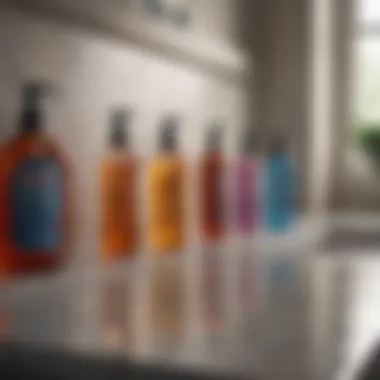
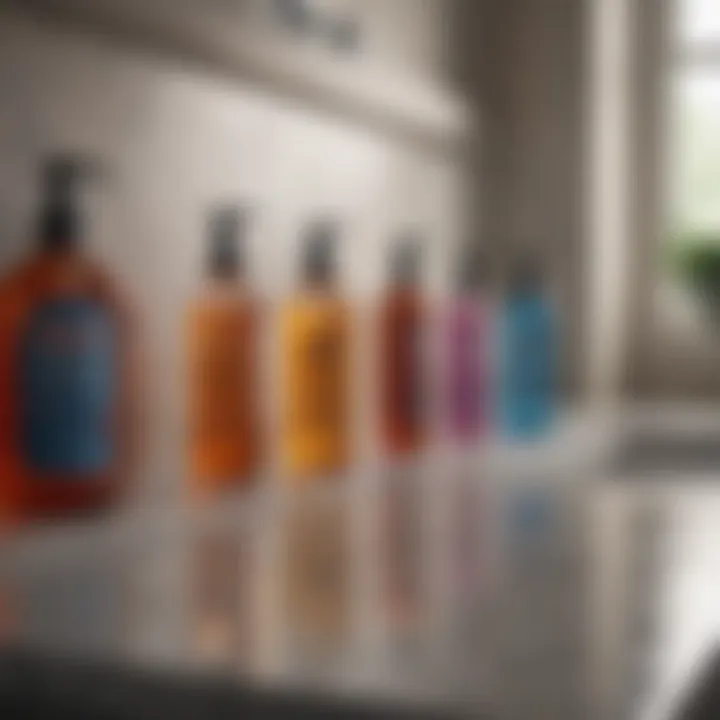
If we break this down, one might think of it as an unwelcome cake frosting that just keeps piling up each time you indulge in the sweet relief of a warm bath. With this in mind, keeping soap scum at bay involves understanding not just cleaning products, but also moisture control in a bathroom and the importance of regular maintenance to disrupt this layering effect before it becomes overwhelming.
"Understanding the enemy—soap scum—empowers you to battle it effectively, allowing you to thrive amid cleanliness and functionality in your bathroom."
The knowledge about soap scum is not merely academic; it sets the foundation for what comes next in our pursuit of an optimal cleaning solution. Knowing how kerfuffles like soap scum work, what they're made of, and why they form helps in making savvy choices when selecting the right cleaners. This path leads us directly into the evaluation of bathroom cleaners—where informed decisions earn their weight.
Evaluating Bathroom Cleaners
When it comes to tackling stubborn soap scum, having the right cleaner can make all the difference. Evaluating bathroom cleaners is not just about picking what's on sale or what looks pretty on the shelf. It's a meticulous process involving various elements that impact how well a cleaner performs in your bathroom. Understanding these factors ensures that the cleaner chosen not only meets cleaning needs but also fits into a larger context of safety and environmental responsibility.
The first step in evaluating is to define what effectiveness means in this context. Different households face varying levels of soap scum build-up, influenced by water hardness and hygiene habits. Therefore, a cleaner hailed as the best in one setting may be less effective in another. Moreover, understanding the various types of cleaners, whether they’re chemical or natural, adds layers to this evaluation process. Each type comes with its benefits and considerations that can significantly impact the cleaning experience.
In short, evaluating bathroom cleaners entails assessing multiple criteria—effectiveness, ease of use, safety profile, and environmental impact. By keeping these elements in mind, housewives and homeowners alike can make informed choices that cater to their specific needs.
Criteria for Judging Effectiveness
When judging the effectiveness of bathroom cleaners, several factors come into play:
- Cleaning Power: This is the number one priority. A cleaner must seize the task of breaking down soap scum without needing excessive scrubbing.
- Time Efficiency: Instant action is a crucial aspect for busy households. Many people want results without waiting ages for a cleaner to work.
- Surface Compatibility: It's vital to ensure that the cleaner will not damage surfaces like glass, tile, or chrome, which are common in bathrooms.
- Odor: The scent can make or break a product’s appeal. A pleasant scent can make chores more enjoyable, while harsh chemical odors might have the opposite effect.
- Ease of Use: Packaging that simplifies application can be a huge plus. Look for products with user-friendly instructions.
Types of Cleaners: Chemical vs Natural
The choice between chemical and natural cleaners can be a point of contention among homeowners. Both have their place depending on individual cleaning habits and values.
Characteristics of Chemical Cleaners
Chemical cleaners are often seen as powerhouse solutions. These cleaners typically pack a strong punch when it comes to breaking down stubborn residue. One key characteristic of chemical cleaners is their active ingredients designed specifically for tough jobs, like phosphoric or hydrochloric acid. These components can dissolve built-up soap scum faster than many natural alternatives, making them a popular choice for entrenched grime.
"While chemical cleaners can be tough on dirt, they also require respect and careful handling to avoid unintended effects."
However, they bring disadvantages as well. For one, chemical cleaners can pose safety risks if not used properly. People with allergies or sensitivities might find themselves reacting negatively. Plus, there’s the environmental angle—many chemical cleaners contribute to pollution and waste, raising questions regarding sustainability.
Benefits of Natural Cleaners
Natural cleaners have gained traction for several fantastic reasons. Primarily characterized by their use of safe, biodegradable ingredients, these cleaners often include substances like vinegar, baking soda, or essential oils. A key benefit is their relatively low toxicity, allowing families with young kids or pets to use them without as much worry. They cleanse surfaces effectively, but usually over longer time frames, relying on gentler properties, which makes them better for regular maintenance.
Nonetheless, it's vital to acknowledge that while natural alternatives are friendly to both users and the environment, they may not perform as quickly or powerfully as their chemical counterparts on heavy soap scum.
In summary, knowing the characteristics of chemical versus natural cleaners not only aids in understanding their practical implications but shapes the overall efficacy in the bathroom cleaning regimen. Selecting the right type hinges heavily on personal preference, specific cleaning challenges, and a broader viewpoint on health and the environment.
Top Commercial Cleaners for Soap Scum
When it comes to tackling soap scum, a dedicated cleaner often makes the difference between a sparkling bathroom and a scrappy one. Top commercial cleaners for soap scum not only promise ease of use but also deliver real results that can save time and effort. Identifying the right product involves understanding its formulation, effectiveness, and the way it interacts with stubborn build-up.
A significant factor to consider is how quickly and effectively a cleaner can dissolve soap scum. Time-saving features and efficiency are often at the top of any householder's list when cleaning, especially with hectic schedules. Therefore, the following commercial products cater specifically to this pressing concern, ensuring the greatest benefits for homeowners seeking cleanliness and shine.
Product A: Features and Benefits
Product A, let’s say it’s called ScrubMaster Soap Scum Remover, boasts a specially formulated blend designed for tough soap scum stains. One notable feature is its ability to cling to vertical surfaces, allowing it to break down grime without immediately dripping away.
- Key Features:
- Thick formula that adheres better
- Fast-acting agents that start working within minutes
- Pleasant scent that neutralizes odors while cleaning
By using ScrubMaster, you can see immediate results. Homeowners have reported vastly reduced scrubbing time as it effectively loosens build-up. It is formulated to be safe on various surfaces, supporting household versatility. However, it is wise to always test on a small area first.
Product B: Effectiveness and User Feedback
Moving along, let’s consider Product B, known as ClearClean Ultra Gel. This renowned cleaner has garnered a loyal following due to its effectiveness. Customers rave about its ability to eliminate soap scum with minimal effort.
Feedback from users generally highlights:
- Quick and Efficient: Many claim they could see a visible difference after just one application.
- User-Friendly: Spray, wait a short time, rinse off—but not all cleaners offer the same ease.
- Suitable for Regular Use: Homeowners appreciate that it can be used as part of a routine cleaning strategy without being harsh on surfaces.
However, not all reviews are glowing. Some users caution against using ClearClean on glass surfaces without thorough rinsing, as build-up can result if left unattended. Balancing these mixed reviews is essential for potential buyers looking to find their match.
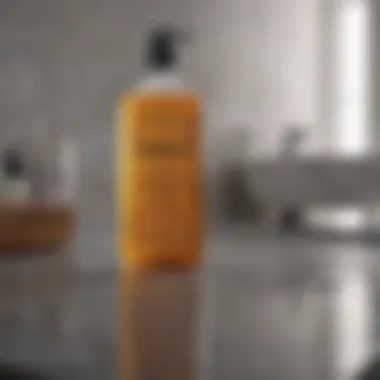
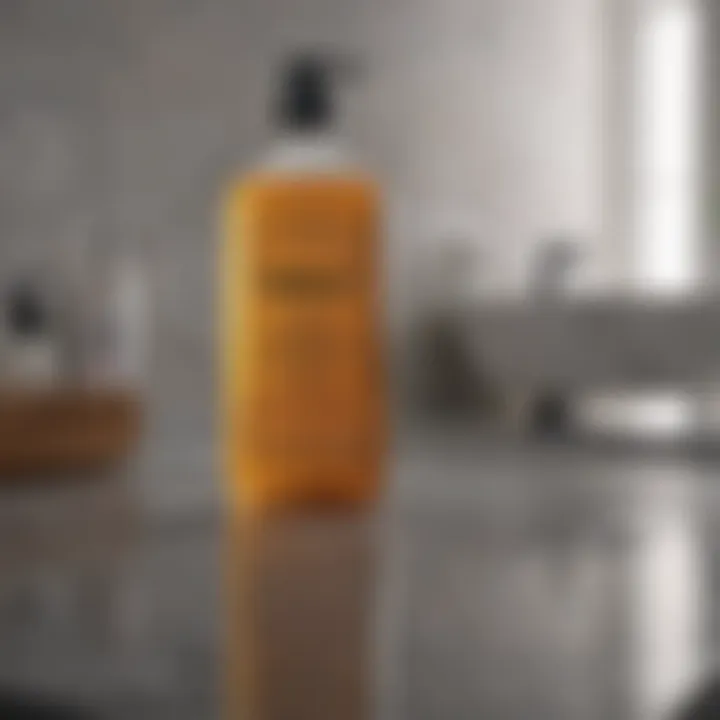
Product C: Comparison with Competitors
Finally, let’s talk about Product C, which we’ll refer to as StainAway Pro. It stands out in the market for its eco-friendly formulation, aiming to reduce the environmental impact while still delivering results. When we compare StainAway Pro to other cleaners like ScrubMaster and ClearClean, there are a few points worth noting:
- Eco-Friendliness: StainAway uses plant-based ingredients, appealing to environmentally conscious consumers, whereas others rely on stronger chemical formulas.
- Surface Compatibility: It is gentle enough for use on marble and granite, making it a preferred choice for those with high-end finishes in their bathroom.
- Price Point: The cost of StainAway Pro can be slightly higher than ScrubMaster, but many find its eco-friendly status justifies the expense.
"The trick to a clean bathroom is knowing which tool to use. Remember, not all cleaners are made equal; choose wisely!"
For those balancing effectiveness with environmental considerations, understanding these subtle yet impactful differences is essential. Each of these top commercial cleaners serves different needs and preferences, enabling housewives and homeowners alike to make informed choices.
DIY Alternatives for Soap Scum Removal
When it comes to tackling soap scum, many folks instinctively reach for commercial cleaners that often come packaged with strong chemicals and hefty price tags. However, DIY alternatives provide a more economical and eco-friendly approach. Not only can these homemade solutions cut through soap scum effectively, they also come with additional benefits like ease of preparation and reduced chemical exposure in our living spaces. This section delves into two popular DIY alternatives: the vinegar and baking soda solution, and essential oils for enhanced cleaning.
Vinegar and Baking Soda Solution
Combining vinegar and baking soda is a classic cleaning trick many swear by. The acetic acid in vinegar acts as a powerful agent against build-up, while baking soda serves as a gentle abrasive that effectively scrubs away residues.
To create this solution, you simply need:
- 1 cup of vinegar
- 1/2 cup of baking soda
Here’s how you can put it into action:
- Mix the vinegar and baking soda in a bowl. Expect fizzing; that’s just the reaction at work.
- Allow the mixture to bubble for about ten minutes.
- Apply the paste onto areas affected by soap scum, like the shower walls or bathtub.
- Let it sit for roughly 15 minutes, then scrub with a sponge or cloth.
- Rinse thoroughly with water.
This method not only leaves surfaces sparkling but also helps to neutralize odors, providing a fresh scent. Plus, it’s an excellent way of utilizing common household ingredients without breaking the bank.
Essential Oils for Enhanced Cleaning
In the realm of DIY cleaning, essential oils have emerged as a popular contender due to their natural antibacterial properties and delightful fragrances. Oils like tea tree, lavender, and lemon are often favored for their efficacy and scent.
Here’s how to incorporate essential oils into your cleaning routine:
- Choose your preferred essential oil. Lemon might brighten up your bathroom, while tea tree brings robust cleaning power due to its antifungal properties.
- Combine 10-20 drops of essential oil with 1 cup of water in a spray bottle.
- Shake well and spray on the problematic areas. Let it sit for 5-10 minutes.
- Wipe clean with a microfiber cloth or sponge.
Using essential oils not only enhances your cleaning job but also allows you to customize the fragrance to suit your personal preferences, making cleaning feel less like a chore and more like a self-care routine.
DIY cleaning solutions offer not just an effective way to deal with soap scum but are also less harsh on the environment than many commercial products.
By embracing these alternatives, homeowners can cultivate a cleaner home free of harmful chemicals and preserve both the environment and their health.
Application Techniques for Cleaner Effectiveness
Understanding the application techniques for bathroom cleaners is key to effectively combating soap scum. Just like a chef needs the right tools to whip up a masterpiece, so does a housekeeper need the right methods to achieve a spotless bathroom. The way a cleaner is applied influences its effectiveness, ensuring that every nook and cranny is reached and treated.
Preparation of Surfaces
Before diving into the actual cleaning, it’s essential to prepare the surfaces. This initial step can make or break your cleaning endeavor. Dust and dirt can hinder a cleaner’s effectiveness, leading to inadequate results. To start, wetting the surfaces with water helps remove loose grime and also primes the area for the cleaner. A quick wipe with a damp rag or sponge ensures that any stubborn bits of debris don’t interfere with the cleaner’s job.
Moreover, ensuring good ventilation in the bathroom encourages proper drying and helps to keep air fresh, which is particularly important if using strong chemical cleaners. These preparatory actions create the perfect environment that allows your chosen cleaner to work its magic effectively.
Optimal Application Methods
Spray vs Wipe
When it comes to the age-old debate of spray versus wipe, each method harbors unique attributes. Spraying a cleaner can cover a broader area quickly, reaching spots that might be difficult to wipe down. This is particularly advantageous for expansive surfaces or tricky corners. On the downside, too much spray can lead to oversaturation, potentially wasting product and creating bigger drips.
Wiping, however, provides precision. It lets you focus on specific spots, ensuring that tough soap scum is given the attention it needs. While it may take more elbow grease, this method often lifts grime more effectively from textured surfaces. For many, combining both techniques—spraying initially and wiping afterward—can create an optimal cleaning strategy.
Scrubbing Techniques
Next up, we delve into the scrubbing techniques, which are indispensable for tackling stubborn soap scum. Utilizing a brush, sponge, or scouring pad can significantly enhance cleaning efficiency. Scrubbing applies pressure and agitation to the surface, helping to dislodge built-up soap scum that mere wiping may not eliminate.
A key feature of scrubbing techniques is their ability to adjust pressure based on the surface material. For instance, a soft brush works well for delicate tiles while a firmer pad can tackle tougher stubborn spots.
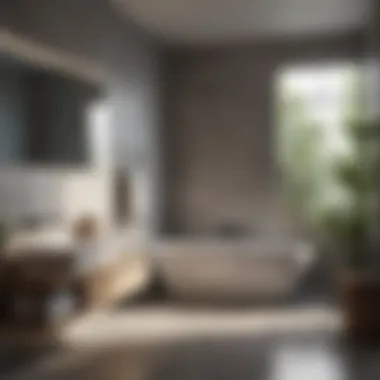
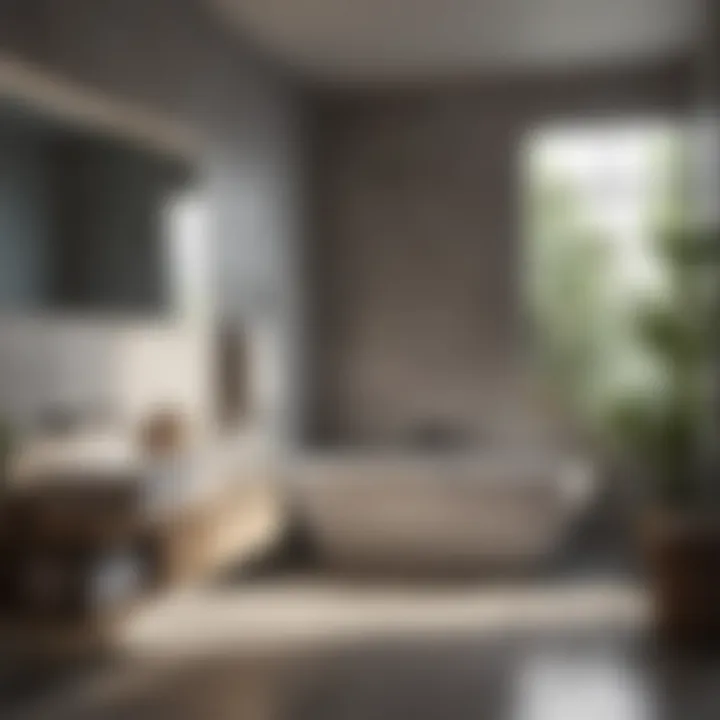
However, caution is essential. Too abrasive tools run the risk of scratching or damaging finishes. Thus, selecting the right implement based on cleaning needs and surface type is critical in this process.
By mastering these application techniques, you can elevate your bathroom cleaning routine from mundane to meticulous, ensuring the best possible results against the odds of soap scum.
Safety Considerations When Using Cleaners
When it comes to cleaning your bathroom, particularly when battling the ever-persistent soap scum, safety can easily fade into the background. However, prioritizing safety is crucial not just for your wellbeing, but for maintaining a clean and functional space free from hazards. Engaging with various chemical agents without understanding their implications can lead to mishaps—from skin irritations to respiratory issues. The matter requires thoughtful consideration, ensuring you approach your cleaning tasks with a clear understanding of how to protect yourself.
Adhering to safety guidelines while using strong bathroom cleaners has several benefits, including reducing the risk of health complications and preserving the longevity of the surfaces you're cleaning. It’s essential to not just be mindful about how effectively these cleaners can tackle soap scum but also about their safety profiles. This balancing act is pivotal for not only achieving cleanliness but also ensuring a safe home environment.
Protective Gear Recommendations
To keep yourself in tip-top shape while tackling soap scum, consider investing in protective gear. Here’s what you should consider wearing:
- Gloves: Rubber or nitrile gloves are a smart investment. They shield your skin from harsh chemicals, helping to avoid irritation or allergic reactions.
- Goggles: Protect your eyes from splashes. If a product inadvertently sprays, you’ll be thankful for an extra layer of protection.
- Mask: Many cleaners emit fumes. A simple mask can minimize inhalation of potentially harmful vapors, especially in poorly ventilated spaces.
- Apron: An apron or old clothing can help shield your attire from unexpected spills.
Ensuring you gear up before diving into your cleaning session is a small yet significant step toward a safer environment.
Understanding Labels and Ingredients
Label reading may not be the most thrilling task, yet it’s an important one. Cleaners often list a plethora of ingredients, some of which may pose risks. Here’s how to decode what’s behind those labels:
- Active Ingredients: Identify the key components that deliver cleaning power. Look for potent agents against soap scum, such as citric acid or sodium hydroxide.
- Safety Warnings: Pay particular attention to any hazard symbols or warnings. These can signal toxicity, flammability, or corrosive properties—knowledge that can be the difference between a safe cleaning experience and an emergency.
- Usage Instructions: Follow recommended application methods precisely. These instructions are designed to maximize efficiency while minimizing hazards.
- Environmental Considerations: Some products degrade quickly in the environment, while others can linger and pose risks. Make an effort to choose cleaners that are less harmful to our planet.
By familiarizing yourself with product labels, you can make informed decisions that enhance your safety while cleaning. Understanding what you’re putting in your space will provide a sense of assurance and competence.
"Safety isn’t just a priority; it’s a practice that protects your health and maintains the integrity of your home."
Overall, ensuring safety while using bathroom cleaners is not merely an afterthought; it is an essential practice that demands attention. By gearing up and understanding product specifics, you not only protect yourself but also create a cleaner and more enjoyable living environment.
Environmental Impact of Bathroom Cleaners
Understanding the environmental impact of bathroom cleaners hasn't been as high on the radar until recent times. There's a growing awareness that the choices we make in our cleaning rituals go beyond just keeping our bathrooms sparkling. Each product can affect not only the surfaces we scrub but also the ecosystem. The chemicals found in many traditional cleaners can leach into our waterways and contribute to pollution, which brings serious ramifications for marine life and ultimately impacts us too.
When we look closely at the prevalence of soap scum, it's common to think mainly about combating the mess. However, this task can come with costs; certain cleaners contain harsh ingredients that might do more damage than good. By selecting environmental-friendly products, you’re not just addressing soap scum; you’re investing in the health of our planet. It's essential to weigh both personal and broader ecological considerations when choosing a cleaner.
Eco-Friendly Product Options
Eco-friendly bathroom cleaners are gaining traction fortunately. More brands are now developing products that cleanse effectively without the negative environmental footprint. Here are some viable options:
- Plant-Based Cleaners: Often derived from natural ingredients, like essential oils and botanical extracts, these cleaners provide reasonable power against soap scum, often found in brands like Method and Seventh Generation.
- Biodegradable Formulations: Unlike conventional cleaners, which may take ages to break down, biodegradable formulations offer peace of mind as they decompose quickly and safely in the environment. Brands like Ecover and Mrs. Meyer's take pride in this quality.
- Refillable Systems: Some companies, such as Cleancult, are creating concentrated cleaners that come in reusable packaging. This approach not only minimizes waste but also reduces the transport-related carbon emissions associated with shipping heavy liquids.
Choosing eco-friendly products means evaluating labels and committing to purchases that align with environmental values. Often, these products perform just as well, if not better, than their chemical counterparts.
Reducing Waste and Chemical Use
Being conscientious doesn't just come from product choice; it's also about how we use these products. Here are ways to cut down on waste and chemical use:
- Dilution of Cleaners: Many commercially available cleaners can be diluted with water, stretching their usability further while minimizing over-application.
- Avoiding Single-Use Wipes: Opt for washable cloths instead of disposable wipes. They not only clean more effectively but also drastically cut down on paper waste over time.
- Batch Cleaning Solutions: Making larger quantities of cleaning solutions at once can lessen the need for single-use bottles. This can work especially well with DIY solutions using vinegar and baking soda; they are both effective and green alternatives.
To encapsulate, reducing waste and being mindful of chemical usage isn't merely an option; it's becoming a necessity. The choices we make influence our health and the environment as well. As stewards of our homes, making informed cleaner choices can contribute positively to our bathrooms and the planet.
As you wholly examine what cleaner to choose, remember: it's not just about soap scum removal; it's about fostering a sustainable future.
Finale: Choosing the Best Cleaner
When it comes to selecting the right cleaner for soap scum, the decision is not as straightforward as one might think. The bathroom is a space that demands both cleanliness and safety, impacting not just aesthetics but also overall hygiene. Hence, finding the optimal cleaner becomes an exercise in assessing personal needs and preferences while balancing effectiveness with safety and environmental considerations.
Evaluating Personal Needs and Preferences
Before diving into product options, it’s crucial to pinpoint what you need from a bathroom cleaner. Some questions to ponder include:
- Do you prefer natural ingredients or are you comfortable with chemical formulations?
- How sensitive are you or your family members to strong scents or potential irritants?
- Are you looking for a product that offers multi-surface cleaning, or do you need something specifically targeting soap scum?
- How often do you clean your bathroom? This could affect your choice of a product that’s either a quick-fix or a heavy-duty option.
Taking your household's unique dynamics into account is essential. For instance, if you have small children or pets, going for a more eco-friendly option might be wise, even if it means targeting soap scum more frequently. On the other hand, if you live alone and prefer quick clean-ups, a robust chemical cleaner could meet your needs effectively without sacrificing cleanliness.
Final Recommendations Based on Analysis
After thorough consideration of the discussed cleaning solutions, it’s easier to reach a recommendation tailored to specific needs. Here are a few pointers:
- Chemical Cleaners: For those who want immediate results and don't mind the strong chemicals, products like CLR Mold and Mildew Stain Remover could be optimal. They cut through soap scum relatively quickly but come with the necessity for precautionary measures.
- Natural Alternatives: If you stand for eco-friendliness, Seventh Generation Shower Cleaner or a homemade vinegar and baking soda mixture can suffice. These alternatives are gentler on surfaces and users.
- Maintenance Routine: For long-term effectiveness and maintaining a clean bathroom, consider establishing a regular cleaning schedule. Using a lighter cleaner after your deep clean can help prevent soap scum build-up without the hassle of using heavy-duty products frequently.
In summary, while this journey through cleaning options might seem daunting, understanding your specific preferences and requirements can simplify the decision-making process. Approaching the task with this mindset not only sets you on the path to a cleaner bathroom but also contributes to achieving a safer environment for everyone involved.



